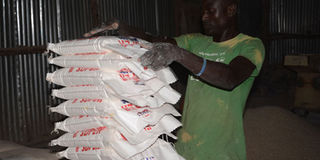How farmers are milling profits from maize

A farmer counts bags of maize flour after milling. PHOTO by George Katongole
What you need to know:
To sustain the maize, the farmers charge a milling fee of Shs180 to clients, which farmers say is competitive compared to private millers, who charge about Shs200, writes George Katongole
Maize milling is a big business in Uganda because maize flour is an important staple food for most families.
Factories, most of which are small scale, have been established around the country as part of the maize value chain for maize. The year 2018 was so horrible for several farmers that did not have a mechanism to store grains or sell processed flour as a kilogramme of maize was being sold for about Shs200.
In January 2014, 32 farmers in Kiryandongo under their umbrella association Kigumba Produce Buyers and Dealers Association (KPBDA) came together to add value to their maize, instead of selling grains to Kampala.
The association needed to acquire a maize milling plant to process maize flour for the local markets. Yet they did not have the required money to acquire the plant. With the help of National Agricultural Research Organisation (Naro), they are now living their dream.
Today, the association has grown to a membership of 63 people since receiving a milling machine with a huller and mill in 2015.
Located in the heart of the town, the maize milling project removes the maize bran off the grains, which is sold to retailers as well as other markets in Apac, Gulu and Masindi.
At the heart of their business, KPBDA permanently employs machine operators while other costs are borne by customers. Maize is a key crop in Kiryandongo District but with growing competition, the association pays a slightly higher value to farmers.
According to Christopher Waiswa, the secretary of the association, they pay Shs700 at the farm while those who prefer to bring their produce to the mill, take Shs750. To help sustain the plant, they charge a milling fee of Shs180 to clients, which Waiswa says is competitive compared to private millers, who charge about Shs200.
The business environment for the millers is described as being difficult. Waiswa noted that unreliable power supplies and high charges limit their production capacity.
He said they can produce about two tonnes every 24 hours yet in September, they operated for only five days. Spare parts for the machine are also problematic.
There is need for labour, which Waiswa says is not specialised. Maize milling typically involves a process of soaking the maize, de-hulling, sifting the de-hulled maize, and milling the maize to produce flour. Waiswa says that all those processes are done by casual labourers.
The plant has limited technology and skills, typical of most small-scale millers as well as inadequate capital to procure sufficient quantities. The packaging materials, which they buy from Kampala, are also expensive.
For someone willing to invest into a milling machine, Waiswa says taking into consideration the costs involved is important. He has been studying profitability of mills since he left his home in Kamuli in 2015 to go to Kigumba, which is now his second home. He offers the following breakdown: price of maize per 100 kilogrammes, electricity unit price, water unit price, labour costs, premises rental, fortification additives and packing bags.
He advises on understanding the market price of maize flour, maize bran and related transport costs.
It would be better to source maize growers and sign a contract so as to eliminate the untrustworthy and unreliable middlemen who tend to cheat both the buyer and the farmer. The major maize growing districts in Uganda include Mubende, Kiryandongo and Masindi.
A mill requires large space for storage purposes. The premises need to have access to three-phase electricity since the machines need high voltage.
You can upgrade with the help of the electricity supply company, Umeme. Umeme will charge inspection fees of Shs88,000. A unit of power goes for about Shs868 during the peak hours.
The premise location and construction should follow the standards for both quality and safety. You need to consult a food technologist to help you identify the standards that you require with guidance from the Uganda National Bureau of Standards (UNBS). These standards give you the set of requirements needed in order for you to produce products that are fit for human consumption.
Get your business registered with the Uganda Registration Service Bureau (URSB) as well as Uganda Revenue Authority (URA), Uganda National Chamber of Commerce, municipal authorities and National Social Security Fund (NSSF).
After machine installation, produce a sample of products to take to an accredited laboratory such as Uganda Industrial Research Institute (UIRI) or UNBS and have the sample analysed for chemistry, physical and microbiology. This helps you to apply for product certification.
The next thing is knowing the market and methods for payment collection as majority of the biggest buyers such schools and retailers buy on credit. Maize mills of different capacities can be obtained at John Deere, China North Machines, Amek machines as well as online sources such as Alibaba.
Fortification
Maize flour is thought to be an attractive vehicle for fortification because it is a staple food for a large proportion of the population, including poor and vulnerable households who consume it regularly.
In Uganda, it is estimated that 95 per cent of maize flour is being produced by small and medium-scale hammer miller operators.
Fortification is an opportunity KPBDA millers identified, yet they are yet to put it into practice.
Fortification boosts micronutrient content which ultimately improves the nutritional status.


